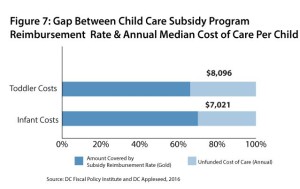All families should have access to high quality care and education for their young children. And we know that quality care is expensive. So, how can we ensure that providers offering this early care and education to mostly low-income families are adequately funded?
In case you missed it, DC Fiscal Policy Institute and DC Appleseed released a report focused on the costs of providing early care and education for infants and toddlers last week. Over the next several weeks, we’ll be sharing more about what we found and the changes we suggest to improve the city’s early care and education system.
To start, it’s important to understand how the DC child care subsidy program works. Low-income families can qualify for financial assistance from the government to help offset the costs of child care while they are pursuing work, education, or training opportunities. The centers and homes that provide care for these families are then reimbursed by the government at certain rates, based on the age of the child, the type of setting, and quality tier of the provider.
Our analysis shows that current child care subsidy reimbursement rates cover only 66 to 70 percent of the median cost per child for infant and toddler care in an accredited environment. In addition to subsidy, early care and education providers can receive support from private-paying families, other government sources, fundraising efforts, or in-kind resources. However, in some neighborhoods few families earn enough to pay the market rate and must rely on the subsidy program. In these neighborhoods, many providers struggle to make ends meet on the low reimbursements from the subsidy program, while meeting standards for quality. Many providers we interviewed reported operating at a loss, paying low wages to staff, or even going into personal debt to float their business operations.
Providers serving our most vulnerable children should not have to be forced to choose between paying staff a competitive wage and covering the cost of caring for a child whose family cannot afford to pay. That’s why one of our recommendations is to increase child care subsidy rates and other government services to cover the gap for high-quality providers. For gold-rated centers, we estimate the total investment needed is $38 million, which can be phased in over time. This increased investment does not need to come out of the child care subsidy program alone, but could include other public programs that offer support to providers, such as Healthy Futures or Strong Start, as well as private resources to build up our city’s early care and education economy.
To read the full report, click here.
To print a copy of today’s blog, click here.

